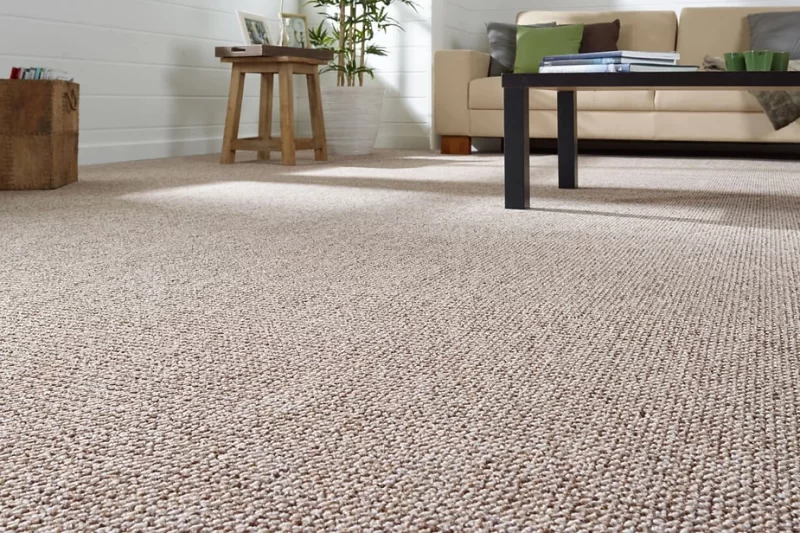
Wool carpet is a choice of carpet flooring that was once popular but due to so many different types of choices now available, wool isn’t such a popular choice anymore. One of the main reasons is that wool carpets and their many different weaves have become so expensive that it may be a choice that many households may not afford to invest in. However, you may think twice, given the following benefits that wool has over most other carpets sold on the market. It is better to consider it an investment in quality and durability for the long haul than cheap savings in flooring costs.
Here are 9 benefits of wool carpet should you consider investing in your home flooring:
- Durability: Wool fibres are naturally strong and have a strong resistance to wear and tear compared with others on the market. This makes wool carpets a great choice, especially in high-traffic areas.
- Insulation: Wool fibres have great natural properties, which makes them ideal for use in colder climates. Its natural ability to keep the room warm in winter and cool in summer is unmatched. Along with keeping rooms warm, it also has excellent sound insulation properties, especially in high-rise dwellings where neighbours are either side or below you.
- Resilience: Wool fibres have a natural ability to bounce back from crushing and matting, which helps to maintain the appearance of the carpet.
- Eco-Friendly: Wool is a natural, renewable resource, and it is biodegradable. Carpets made from wool are also naturally flame-retardant and do not release harmful chemicals.
- Hypoallergenic: Wool fibres are naturally hypoallergenic, making them a great choice for people with allergies or sensitive skin.
- Variety: Wool carpet comes in a wide range of styles, colours, and patterns, so it’s easy to find one that complements any room’s decor.
- Sustainable: Wool is a renewable resource and wool carpets can be recycled at the end of their life.
- Comfort: Wool fibres are soft and springy, providing a comfortable walking surface.
So here you see, wool carpet is a durable, comfortable, and eco-friendly flooring option that can add warmth and beauty to any room in your home. With its natural properties, it is a worthwhile investment.
Wool Carpet Maintenance Made Easy: A Step-by-Step Guide
- Vacuuming: Regular vacuuming is the most important step in maintaining the appearance and prolonging the life of the wool carpet. It helps to remove dirt and debris that can dull the fibres and cause wear and tear.
- Blotting: In case of spills or stains, it’s important to act quickly and blot the affected area with a clean, white cloth. Never rub the stain, as it can cause the fibres to mat and damage the carpet.
- Spot Cleaning: For small spills or stains, a spot cleaning solution specifically designed for wool carpets can be used. Always test the solution on an inconspicuous area first before applying it to the stain.
- Professional Cleaning: For heavy soiling or deep cleaning, it’s recommended to hire a professional carpet cleaner who is trained in cleaning wool carpets. They use specialized equipment and solutions to effectively remove dirt and stains without damaging the fibres.
- Avoid Over-Wetting: When cleaning wool carpet, it’s important to avoid over-wetting the carpet. Overwetting can cause shrinkage, matting, and discolouration. It’s recommended to use a small amount of water and a clean, white cloth or sponge.
- Avoid harsh chemicals: it’s important to avoid using harsh chemicals such as bleach or optical brighteners on wool carpets, as they can damage the fibres. It’s recommended to use pH-neutral cleaning solutions specifically designed for wool carpets.
It’s important to note that regular vacuuming and prompt attention to spills and stains can help prevent dirt and stains from setting in, making maintenance and cleaning much easier.
Hot Water Extraction: The Secret to a Fresh and Clean Wool Carpet
Hot water extraction is the process of using hot water, usually from 60 degrees (140F) to 100 degrees (212F) boiling point, to sanitise and clean wool carpets. Hot water is delivered through a high-pressure hose, dissolved, and sanitised and dirt is extracted through a larger waste pipe. This process is the most effective way of cleaning wool carpets. Hot water extraction is also known as steam cleaning. Some benefits of hot water extraction for wool carpets include the following:
Deep Cleaning: Hot water extraction penetrates deep into the fibres of the carpet, removing dirt and stains that may not be removed by other cleaning methods. The heat and pressure dissolved most dirt, oils and stains. Used in conjunction with recommended wool carpet cleaners makes, this method is even more effective.
Sanitization: The high water temperature used in hot water extraction can kill most bacteria compared to other methods. It is also effective against allergens, and other microorganisms, leaving your carpet looking cleaner and healthier.
Removing Allergens: Hot water extraction is effective dander, which can trigger allergies and asthma.in removing allergens like dust mites and pets.
Restoring the carpet: Hot water extraction can restore tired and wearing wool carpet, rejuvenating it and making it look as good as new. Regular cleaning by a professional prolongs the life of the carpet.
Removing heavy soil: Hot water extraction effectively removes heavy soil, dirt, and grease from the carpet fibres. Wool tends to hold dirt and dust without dispersing any of it, the hot water extraction would easily dissolve and remove it from the fibres.
No Residue: Hot water extraction method leaves no detergent residue in the carpet, so the carpet dries faster and stays cleaner longer.
Safe for wool: Hot water extraction is a safe cleaning method for wool carpets, as it doesn’t damage the fibres or cause shrinkage.
Overall, hot water extraction is a deep cleaning method that can effectively remove dirt, stains, and allergens from wool carpets while restoring its original appearance, and it is safe for wool fibres.
Healthy Living: More Benefits of Choosing a Wool Carpet for Your Home
Wool carpets offer a number of health benefits that make them a great choice for any home. Some of the main benefits include:
- Hypoallergenic: Wool is a hypoallergenic, natural fibre, making it a great choice for people with allergies or asthma. Unlike synthetic fibres, wool does not attract or hold onto dust mites, mould, or mildew, which can trigger allergies and asthma symptoms.
- Clean Air: Wool fibres naturally absorb and neutralize pollutants, such as formaldehyde and sulphur dioxide, from the air. This makes wool carpets a great choice for homes or offices with poor air quality.
- Insulation: Wool fibres are naturally insulating, which means they can help to keep your home warmer in the winter and cooler in the summer. This can help to reduce energy costs and make your home more comfortable.
- Sound Absorption: Wool fibres are naturally absorbent, which means they can help to reduce noise in your home. This makes wool carpets a great choice for homes or offices with high levels of foot traffic or other noise.
- Fire-Resistant: Wool fibres have a natural flame-retardant property that makes wool carpets less likely to catch fire and less toxic when burning. This can help to make your home or office safer in the event of a fire.
- Durable: Wool fibres are naturally strong and durable, which means wool carpets can last for many years with proper care and maintenance. This makes wool carpets a great long-term investment for your home or office.
- Easy to Clean: Wool fibres are naturally soil-resistant, making them easy to clean and maintain. A good vacuuming routine and spot cleaning when needed can keep your wool carpet looking great for years to come.
In addition, wool carpets are naturally renewable and biodegradable. They are also a sustainable choice for flooring.
Overall, wool carpets are a natural and healthy choice for any home or office. They are easy to maintain, hypoallergenic, and have many benefits that improve air quality, insulation, sound and fire safety and durability.
Discovering the Cost of Wool Carpets for Residential Use
The cost of wool carpet can vary depending on several factors, including the quality and thickness of the wool, the type of weave, and the design or pattern.
On average, a high-quality wool carpet can cost anywhere from $20 to $40 per square foot for the carpet alone, without installation. This can range from around $700 to $3000 for a standard 12×12 room.
Remember that installation costs will vary depending on the complexity of the job and the cost of labour in your area. Additionally, there are also some other factors that can influence the final price, such as the size of the room, the type of subfloor, and whether or not furniture needs to be moved.
It’s important to shop around for the best deal and compare prices from different retailers or manufacturers. Also, it’s worth noting that a wool carpet is an investment which can last for decades if well-maintained and retain its appearance and durability over time.
Longevity at its Finest: Enjoy 20-30 Years of Beauty with Wool Carpet
If you have read our post up until now, you will find that Wool carpet is known for its exceptional durability and longevity. With professional care and maintenance, as outlined in this blog, wool carpets can easily outlast it average lifespan.
So how long, on average, do wool carpets last? On average, wool carpet can last for 20-30 years. However, the lifespan of wool carpets can vary depending on factors such as traffic, environmental conditions, and cleaning methods.
Wool carpet is made from natural fibres, which makes it naturally resistant to wear and tear. The natural oils in wool fibres also help to protect the carpet from soil and stain damage. Additionally, wool carpet is naturally flame-resistant, which helps to reduce the risk of fire damage.
To extend the lifespan of wool carpets, it is important to take proper care of it. Regular vacuuming removes dirt, dust, and other particles that can accumulate on the carpet and cause wear and tear over time. You should also avoid using harsh chemicals or cleaning solutions that can damage the carpet’s fibres.
Wool carpet is also susceptible to fading over time, especially if it is exposed to direct sunlight or other sources of ultraviolet light. To minimize fading, it is recommended to use window coverings, such as curtains or blinds, to protect the carpet from direct sunlight.
Another factor that can impact the lifespan of wool carpet is the amount of foot traffic it receives. High-traffic areas, such as hallways and entryways, may see more wear and tear over time than low-traffic areas, such as bedrooms. To minimize wear and tear in high-traffic areas, it is recommended to rotate the furniture periodically, as well as use carpet protectors under furniture legs.
Lastly, proper maintenance and cleaning are essential to extend the lifespan of wool carpets. Regular professional cleanings can help to remove dirt and debris that can accumulate over time and help to preserve the appearance of the carpet.
Wool carpet is known for its durability and longevity and can last for 20-30 years with proper care and maintenance. By regularly vacuuming, avoiding harsh chemicals, protecting the carpet from sunlight and high traffic, and having it professionally cleaned, you can help to extend the lifespan of your wool carpet and ensure that it remains to look beautiful for years to come.
Wool vs Synthetic: The Ultimate Battle of Carpet Materials
Choosing the right carpet for your home can be quite a challenging task. There are many options to consider. Carpet selection can be broken down into the following categories:
- Natural – Wool, Hemp, Seagrass, Jute, bamboo etc.
- Synthetics – Nylon, Polyester, Rayon, Acrylic etc.
- Tryexta – Not put in the Synthetics category because of its natural content of either corn or sugarcane, which makes it highly resistant to stains. The energy used to make this material is significantly less and it has more eco-friendly properties in it and is associated with the making of it compared to synthetics.
For this content, we will explore the comparisons between wool and synthetic carpets. Both have their own unique benefits and drawbacks, and the right choice for you will depend on your specific needs and preferences. In this article, we will compare wool carpets and synthetic carpets in terms of cost, durability, maintenance, and environmental impact.
Cost:
In terms of cost, wool carpet is generally more expensive than synthetic carpet. This is because wool is a natural fibre that is more difficult to produce and process than synthetic materials. Additionally, wool carpet is often hand-woven, which adds to its cost. Synthetic carpet, on the other hand, is made from man-made fibres such as nylon or polyester and is often machine-made, which makes it less expensive.
Durability:
When it comes to durability, wool carpet is considered to be more durable than synthetic carpet. Wool fibres are naturally resilient, and wool carpet is known for its ability to withstand heavy foot traffic and retain its appearance over time. Synthetic carpets, on the other hand, may not be as durable and may show signs of wear and tear more quickly.
Maintenance:
Wool carpet requires more maintenance than synthetic carpet. It needs regular vacuuming to remove dirt and dust, and it should be professionally cleaned every 12 to 18 months to keep it in top condition. Synthetic carpet is easier to clean, and it is often treated with stain-resistant chemicals, which make it more stain-resistant than wool carpet.
Environmental Impact:
Wool carpet is considered to be more environmentally friendly than synthetic carpet. Wool is a natural, renewable resource that biodegrades faster than synthetic materials. Additionally, wool carpet is often produced more sustainably, with less reliance on synthetic chemicals and pesticides. Synthetic carpet, on the other hand, is made from non-renewable resources and can take hundreds of years to biodegrade.
To conclude this article, both wool carpet and synthetic carpet have their own unique benefits and drawbacks. Wool carpet is more expensive, but it is also more durable and has a lower environmental impact. Synthetic carpet is less expensive and easier to maintain, but they may not be as durable or environmentally friendly. Ultimately, choosing between wool and synthetic will depend on your specific needs and preferences.
Visit https://waratahcarpetcleaningcentralcoast.com/residential-carpet-cleaning-central-coast/ to learn more about our residential carpet cleaning services

Terry is a professional carpet cleaner with over a decade of experience. He’s passionate about using eco-friendly products to provide a clean and safe home for his clients. With a keen eye for detail, Terry tailors his services to meet his clients’ unique needs. He values transparency and excellent customer service, ensuring his clients are satisfied with the results.



